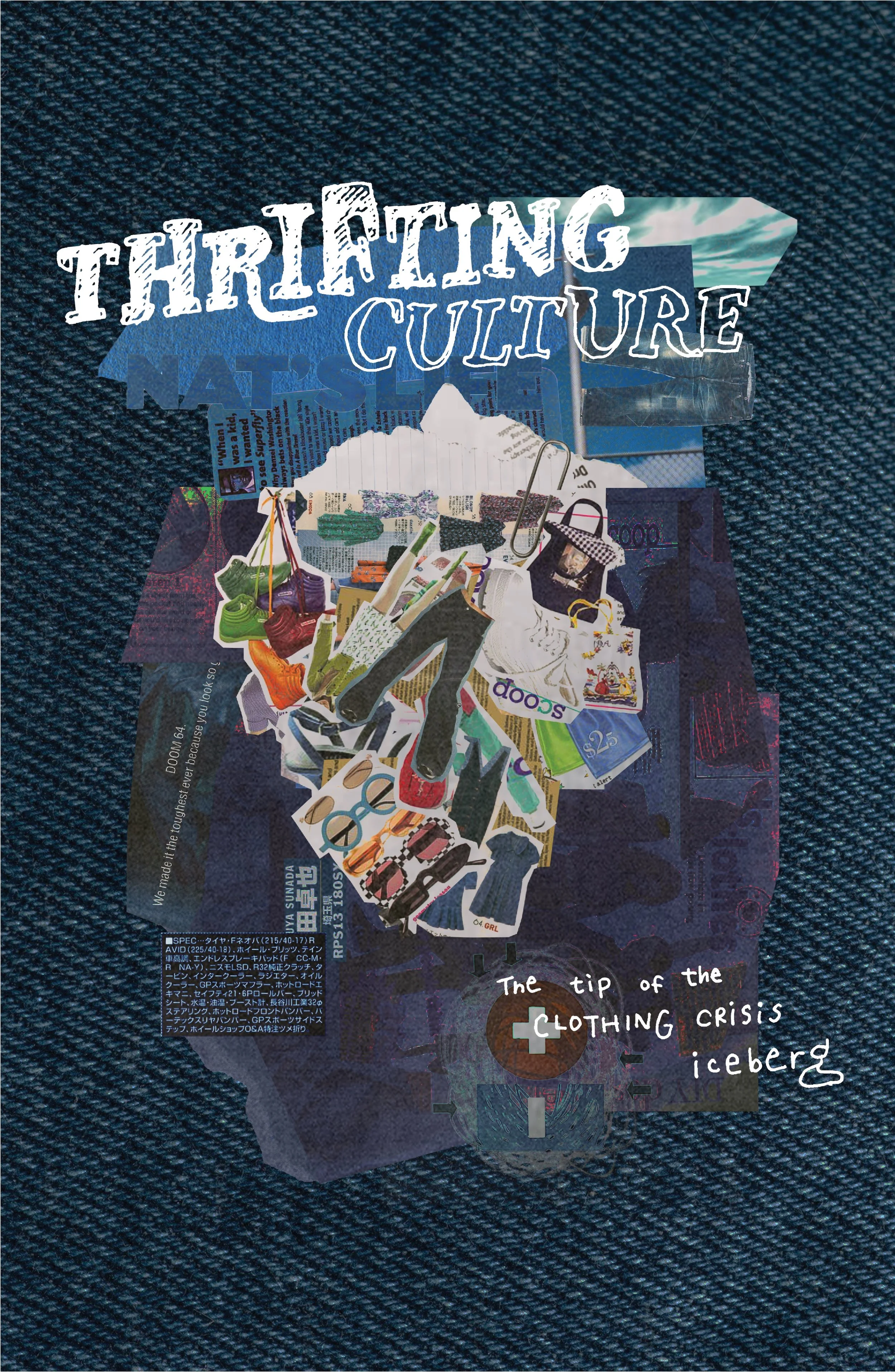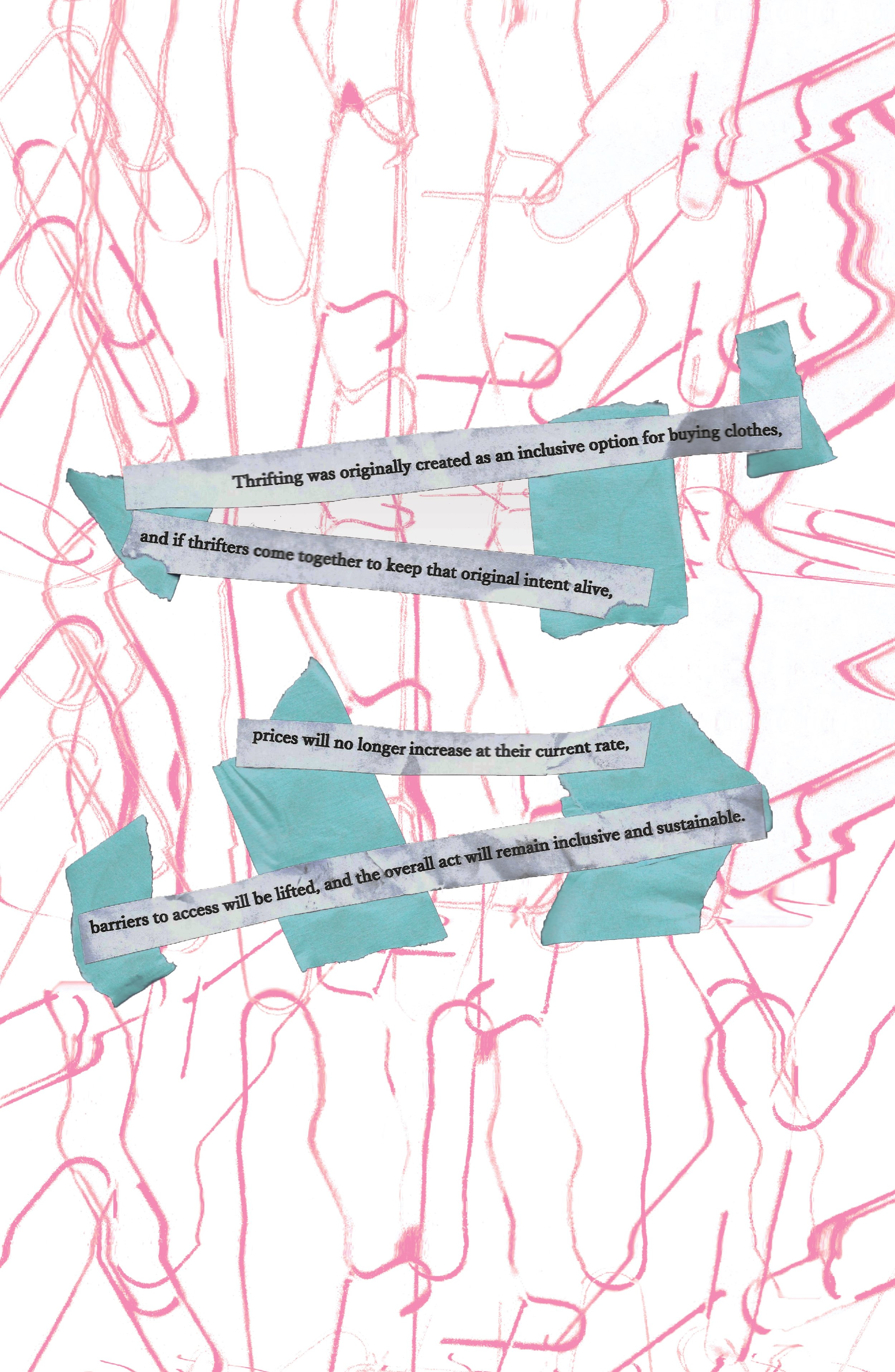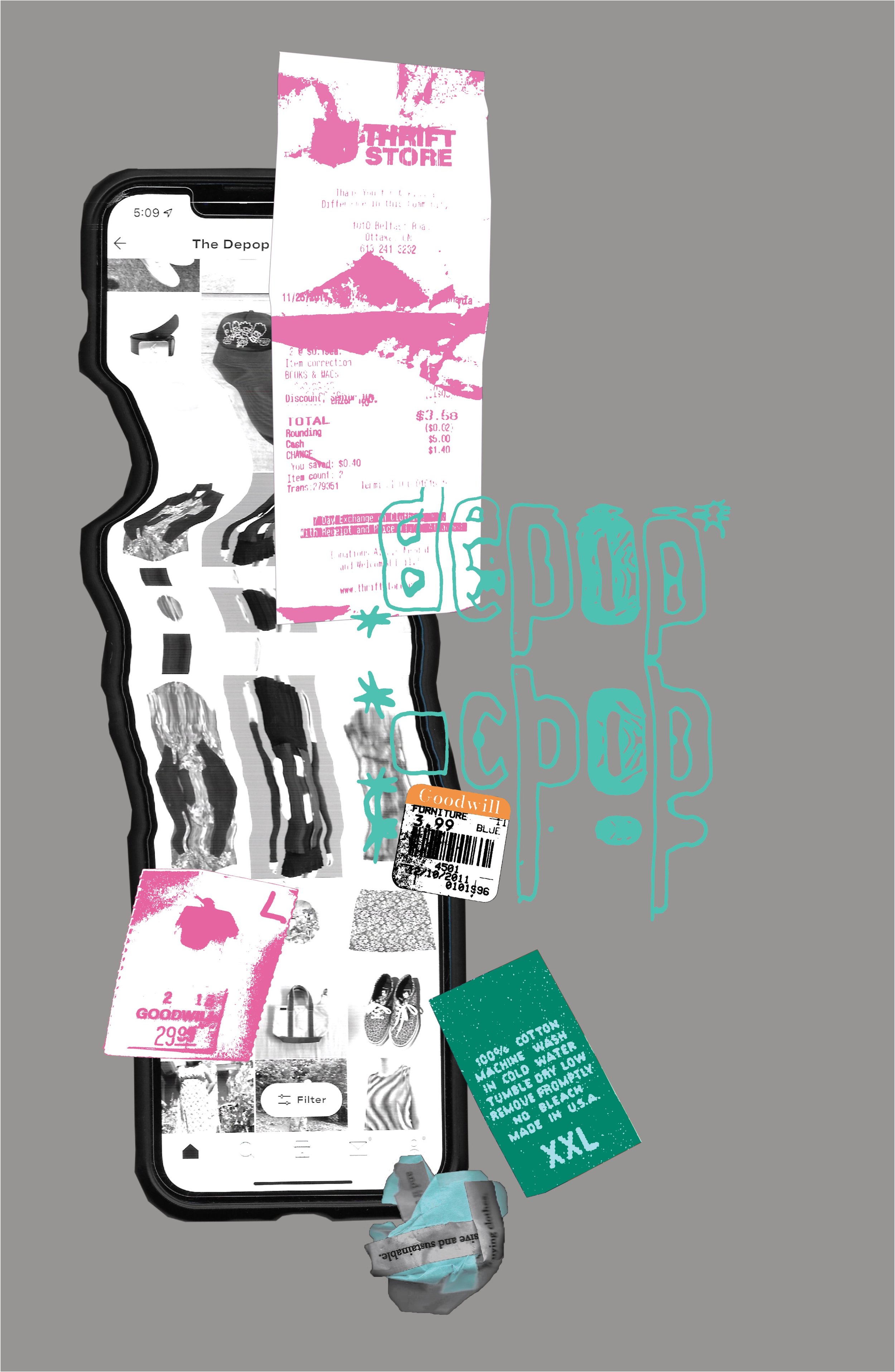Thrifting Culture: The Dangerous Consequences of Irresponsible Thrifting
Written by Kole Kemple
Graphics by Rino Fujimoto
I’m not sure about everyone else, but I’ve recently been obsessed with the side of TikTok that New York City fashion students populate. Creators film short videos of them explaining the makeup of their outfits, citing the price of each item and where they got it from. Oftentimes consisting of various layers and unique textures that shouldn’t work together–but somehow do, it seems at least fifty percent of each of these campy outfits are credited as being a thrift store find. It’s not just the aspiring generation of the fashion industry that has been rummaging through the racks of their local Goodwill. Rather, a large portion of Gen-Z has become recently accustomed to refreshing their wardrobe with thrift store finds.
“Thrifting Culture,” as it is commonly referred to, has offered an alternative method of curating a personalized wardrobe for those no longer interested in the increasing volumes of microtrends often reliant on fast fashion. Rather than ordering the same brightly patterned slip dress from Shien, many teens and young adults find themselves on the hunt for one-of-a-kind pieces that fit their style specifically. Whether they’re going for the seventies or y2k-inspired look, today’s generation of thrifters have modernized the act in a way that interrupts the original intent for secondhand stores and threatens their very existence.
First emerging at the turn of the twentieth century with Salvation Army and Goodwill being founded in 1897 and 1902, respectively, secondhand shops revolutionized the American clothing market. Founded by a Methodist Minister in Boston, Goodwill was originally created as a store intended to not only provide immigrants with work but also opportunities to purchase necessary clothing and items at a fraction of the cost. With the idea of wearing resale pieces looked down upon by middle and upper-class America, thrift stores existed solely for lower-income populations, largely consisting of immigrants, challenged with barriers to access to the prime market. Throughout the rest of the twentieth century and into the beginning of the twenty-first century, thrifting has been practiced by the audience it was originally intended for, until now.
Compared to 2019 data presented by the 2021 Resale Report, an increase of 64% of consumers are open to shopping at secondhand shops and thrift stores. A UC Berkeley study cites that the overall portion of thrifters made up of those a part of the middle class has risen from just below 10% to over 40%. Growing at a whopping eleven times the rate from 2021, resale shops are projected to bring in an increase of 41 billion in total profit by 2025 according to a report done by retail analytics firm, GlobalData. The previous stigma around thrifting’s disappearance can largely be correlated with the 40% of thrifters falling in the category of college-aged Gen-Z shoppers, as identified by the 2021 Resale Report. With the additional mediums of online resale shops, today’s thrifting culture has produced a generation of irresponsible thrifters that endanger the act.
With a good portion of Gen-Z teens and young adults basing their style around a certain aesthetic or hyper fixation, many have turned to online resale shops to search for the items they can’t find at retail chains. Most commonly found on the popular London-based resale app Depop, some thrifters have created specific shops dedicated to selling exclusively thrifted pieces that can be purchased internationally. These shop owners regularly go to local second-hand shops and buy mass amounts of pieces they see potential in for cheap. While some shop owners then continue to customize the pieces, the large majority make no changes to their purchases and, instead, post them with price tags that mirror those of new clothes. While the idea of being able to sell a second-hand t-shirt initially purchased for $2 for upwards of $20 may seem far-fetched, sellers are able to successfully do this by attaching specific descriptive terms to the listing such as “vintage,” or “y2k.” These terms help target the listings to those looking for pieces that fit a certain look, and many are willing to pay the increased price for the second-hand items they otherwise couldn’t find at regular clothing shops. In turn, this process generates mass amounts of profit that continues to fund base purchases from local thrift stores and line the pockets of online resale shop owners, as well as actual thrift store owners. While the intent of opening these shops is not malicious in itself, it encourages a behavioral pattern that warrants dangerous effects on thrift stores.
With the noticed increase of thrifters and overall profit made at second-hand shops, such as Goodwill, thrift stores have begun charging increased rates for their items. Though originally founded with an intent to fill the closets of the lower class population, secondhand shops are still businesses and are bouncing on the opportunity to increase overall profits–even if it spawns restricted access among the original intended audience. A quantitative analysis conducted by UC Berkeley looked directly at the changing prices of clothing at Goodwill. Compared to 2016, when a t-shirt was on average sold for $1, in 2021 the average price for a t-shirt from goodwill was $2.99–an increase of just under 200%. While many would be quick to cite inflation as a factor in these increased prices, inflation actually helps thrift stores because many turn to cheaper options in times of financial hardship, increasing their overall profits compared to years when inflation is on the low. With increased prices, lower-income people are having more trouble purchasing pieces from stores originally intended for them. With what once could have got them five items, many can now only buy two.
Aside from increasing prices and barriers to access among the lower-income population, the recent modernization of thrifting culture has also consequently produced barriers to access among the plus-sized community. On average, thrift stores, and every store for that matter, has a larger selection of straight sizes (small-large), with a limited stock of plus size options. The main reason that this pattern is seen in effect at second-hand shops is simple: more people donate straight-size clothing. Among the portion of Gen-Z shoppers who shop at second-hand shops, many strive for a baggy look, which consequently has them sizing up in clothes and results in them searching through the limited plus-sized inventory instead of their own size. For example, people who normally wear a size medium will justify the purchase of a 2XL pair of jeans by tying a shoelace through the belt loops to fit around their waist. While I love the baggy look as much as anyone else, resellers who purchase the majority of the plus size inventory with the intent of marketing it as “oversized” and “vintage” take clothing away from plus-size people who need to shop at thrift stores, and even middle-class thrifters who were hoping to find a few cute pieces alongside their straight sized friends when shopping.
Due to limited resources that prevent access to luxuries such as organic foods and gym memberships, a good portion of lower-income people fall in the plus-sized range. This pattern is seen especially in urbanized areas where lower-income people are often forced to live in food deserts where the only food options are corner stores and fast food places due to gentrification. With the trend of baggy clothes on the rise, not only do increased thrift store prices prevent lower-income people from finding clothes but they lack sizing options as well. A large portion of secondhand plus-sized items are available for ten times the price on an online Depop shop, instead of being available at the stores where people with limited options go.
Despite the various problems that exist within it, thrifting culture is not inherently bad and the consequences it has produced can be resolved if thrifters begin to shop responsibly. Thrifting is a great alternative to supporting fast fashion and is very beneficial for the environment. The main problem with thrifting is not the group of middle-class friends who decided to stop by Goodwill instead of their local Hollister for back-to-school shopping, but rather the people who own and support online resale shops often found on Depop. As explained previously, these shop owners who make listings by mass purchasing items from thrift stores regularly can be largely credited for the noticed increase in pricing at secondhand shops. Keeping online shops in business by buying multiple $30 items that the shop owners originally found for $5 encourages this behavior and contributes to the overall trend of unsustainable thrifting. Eventually, if this pattern continues, the prices of thrift stores in comparison to regular retail shops will hardly be differentiated, and the original audience for these stores will be left entirely behind.
Even with prices on the rise at thrift stores, rates of donations at places such as Goodwill and Salvation army are increasing as well. When going through their closest, many choose to donate clothes rather than throw them away in hopes they will go to people who need them. However, many people don’t realize that people who need the clothes won’t be able to purchase them due to the consequences of modern thrifting culture. A better alternative to donating to staple thrifting chains is donating to local homeless shelters or churches that give out clothes, free of cost to people who need them. These often overlooked organizations are consistently in need of stock, and an increasing trend of donating to them would provide lower-income people with more sustainable options and go to a better cause.
Thrifting is not a bad thing, just do so responsibly. If you find yourself looking for something to add to your wardrobe, take a chance on your local thrift stores instead of making a habit of supporting Depop shops. If you’re straight-sized and notice that the plus-sized racks have less stock than the straight-sized ones, stick to your size and leave the limited stock for plus-sized thrifters. Thrifting was originally created as an inclusive option for buying clothes, and if thrifters come together to keep that original intent alive, prices will no longer increase at their current rate, barriers to access will be lifted, and the overall act will remain inclusive and sustainable.



